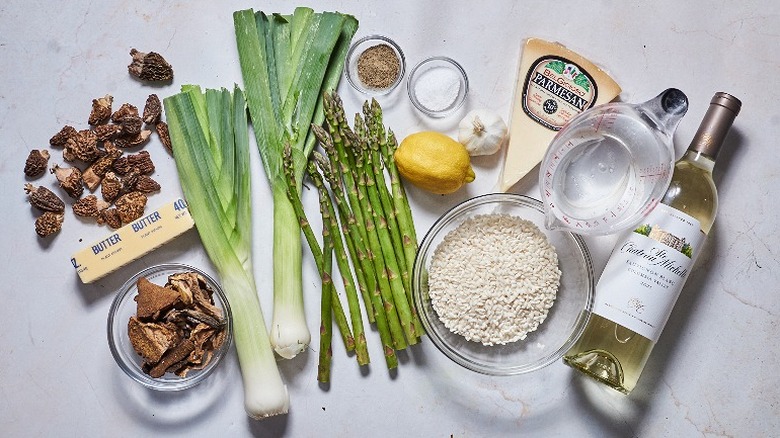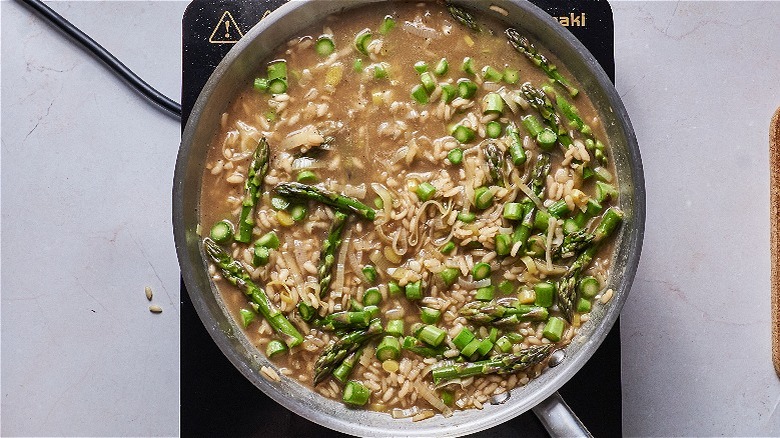Asparagus And Morel Risotto Recipe
When done well, risotto is a thing of beauty. Creamy, rich, and melty, risotto far surpasses your standard rice or orzo (though we love those, too). Made with arborio rice, a type of grain with extra-high starch content, risotto differs from other rice dishes in that the starches form a creamy sauce around the grains when cooked. This doesn't happen with other rice varieties even if you forgo rinsing the grains, which is why risotto is regarded so highly. That, and it takes about 30 minutes of stirring to get it right, which is why you have to respect the arm of a chef with risotto on their menu.
Still, risotto really isn't as mystifying as it's made out to be. It's all about understanding the grain; the rice has to be cooked slowly in constant wet heat to release the starches and cook to a soft (not gummy) al dente. Developer Michelle McGlinn walks through this process below, adding a savory mushroom broth and fresh asparagus for a creamy spring risotto. Got your hands on morels? This is the perfect dish to use them for.
What you need for asparagus and morel risotto
Though you need an exact amount of arborio rice and water, the rest of this dish has some wiggle room. We prefer leeks here for their soft, earthy flavor, but feel free to swap them with shallots or yellow onion. For the mushroom broth, we use dried porcini and fresh morel mushrooms, then reserve the morels for serving. If you love mushrooms or forage your own, you can get creative with which mushroom varieties you incorporate into the cooking broth and risotto itself. If morels aren't in season, just use dried ones or switch them out for another mushroom type like oyster, cremini, or chanterelle. From there, you'll just need a half a bundle of asparagus, which could even be replaced with peas.
Some more common pantry staples that you'll need for this risotto — and most risottos, for that matter — are garlic, butter, lemon juice, white wine, salt, pepper, and freshly grated parmesan.
Prep the veggies
This risotto gets its rich flavor by maximizing the veggies to their full potential. You'll add flavor to the cooking broth by using not only the porcinis and morels, but also the green, tough stalks of the leeks. Slice the white parts to sauté into the risotto, and either discard the end of the bulb or reserve it for the broth, too. Just make sure to rinse the leeks well to avoid grit and dirt in your food.
Next, give the asparagus a little chopping attention so your risotto has a variety of textures. Take a few stems and peel thin, wispy curls from the stalk to reserve for garnish. From there, chop off the gnarly bottoms of the asparagus and slice the trunks into discs about ¼-inch wide. These will cook quickly for easy eating without any tough texture. Leave the tops intact for some added crunch and pretty presentation. Set all these veggies aside while you do the next steps.
Simmer a quick mushroom stock
This will work with fresh mushrooms, but for deeper flavor, seek out dried mushrooms like porcinis (or use dried morels instead of fresh). Add the mushrooms and leeks to the 5 cups of water and bring it all to a simmer over medium-low heat. Heat until the water is amber colored and fragrant, about 10 minutes. Strain the broth and return it to the heat, keeping it just below a simmer. Reserve any mushrooms you'd like to serve the risotto with.
Begin the risotto
Risotto starts a little differently than rice or pasta, as the grains are simmered in wine before any broth is added. Start by cooking the leek whites and garlic in butter until soft and fragrant, then add in the rice so it can lightly toast. When the rice starts looking dry, but not burnt, add the lemon juice and wine and simmer until completely reduced. Start noticing that dry look — that will be your cue for the rest of the ride.
Add broth, stir, and repeat
The next 20-or-so minutes of cooking might seem tedious, but trust the process here: The key is keeping all the grains of rice at a constant temperature to release their starch and cook evenly. To do this, you can't add all of the broth at once. Instead, ladle in about 1 cup at a time and stir until the skillet starts looking dry (remember that from the first steps?) If you're pretty good at multitasking, you can technically step away and wash a dish or two between stirs; just make sure to agitate the rice every couple of minutes to release all those creamy starches. Repeat this process of adding broth and stirring until the grains are chewy but very soft, about 25 minutes. The contents of the skillet should look creamy, but not wet, and the risotto should melt in your mouth on the first bite.
Add the asparagus, mushrooms, and finishing touches
Once you've added that last ladle of broth, add the asparagus, too. It will cook quickly in the hot rice, so don't worry if your risotto is already al dente. Next, add in the parmesan, butter, salt, and pepper. Finally, carefully stir in the morels to heat them through — or, if you don't mind using another pan, consider browning them in some butter beforehand.
Now, here's the really important part: Serve the risotto immediately. Risotto congeals as it sits, thanks to the starches released from the rice. For perfect, creamy risotto, have your serving bowls ready to fill as you stir in the mushrooms. Sprinkle the asparagus garnishes on top and add an extra crack of pepper for good measure, then serve your dish.
Risotto is rich and filling, meaning that a small amount will go a long way. Serve risotto as a side dish to mains like scallops, halibut, or even steaks. To keep it vegetarian, serve with halloumi or braised parsnips. We don't recommend storing risotto for later because of how firm and elastic the texture gets. But if you hate the idea of wasting leftovers, store them in an airtight container in the refrigerator and gently reheat your risotto by adding a little broth or water to help soften the grains.

- 5 cups water
- 1 cup fresh morel mushrooms
- 1 ounce dried porcini mushrooms
- 2 large leeks, washed, greens and whites separated
- 4 tablespoons butter, divided
- 2 cloves garlic, minced
- 1 cup arborio rice
- Juice from 1 lemon
- ½ cup dry white wine
- ½ pound asparagus, trimmed and sliced into ¼-inch pieces
- ½ cup grated parmesan
- Salt and pepper, to taste
- 2 stalks of asparagus, peeled into thin wisps, for serving
- Add the water, morels, porcinis, and green leek leaves to a saucepan over medium heat. Simmer for 10 minutes, until the broth is dark brown. Strain, reserving the mushrooms. Return the broth to medium-low heat.
- In a large skillet or deep frying pan, melt 3 tablespoons of the butter. Slice the whites of the leeks and add them to the butter, then add the garlic and stir until fragrant, about 2 minutes.
- Add the rice and toast for about 3 minutes, until the grains are slightly toasted, but not burned.
- Add the lemon juice and white wine to the skillet and stir. Bring to a simmer over medium heat until the liquid is completely reduced.
- Use a ladle to add 1 cup of warm mushroom broth to the rice. Cook, stirring constantly, until the liquid is absorbed, about 5 minutes.
- Repeat, ladling another cup into the skillet and stirring until absorbed. If the broth is absorbing more quickly than 5 minutes per cup, turn the heat down. The rice should become creamy and begin to soften to al dente over about 25 minutes of cooking time.
- When the last ladle of broth has been added, test the risotto for texture. The rice should melt in your mouth, without any gumminess, and the broth will have turned creamy. If the rice is still very chewy, continue cooking with water until soft.
- Once the risotto is soft, add the asparagus and stir, reducing the last of the broth or water by half and until the asparagus is bright green and tender.
- Add the last tablespoon of butter and the parmesan and stir to combine. Season to taste with salt and pepper, then remove from the heat.
- Fold in the reserved morels.
- Serve risotto immediately, garnishing with peeled asparagus, if desired.
| Calories per Serving | 462 |
| Total Fat | 16.9 g |
| Saturated Fat | 10.1 g |
| Trans Fat | 0.0 g |
| Cholesterol | 43.2 mg |
| Total Carbohydrates | 60.8 g |
| Dietary Fiber | 5.9 g |
| Total Sugars | 4.4 g |
| Sodium | 1,321.0 mg |
| Protein | 13.8 g |







